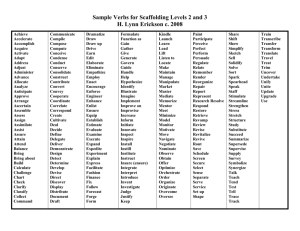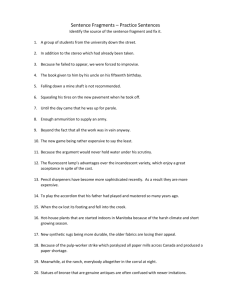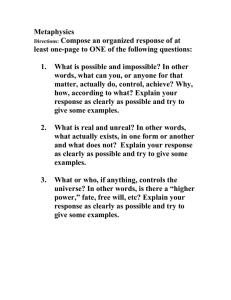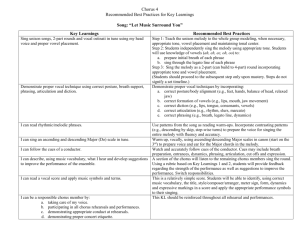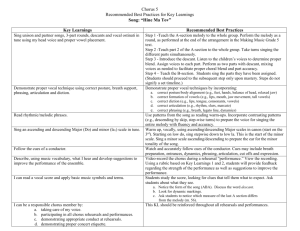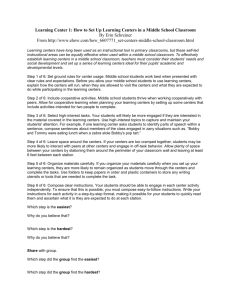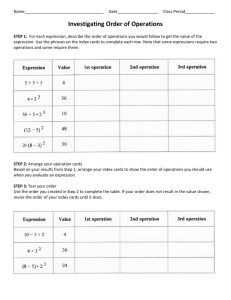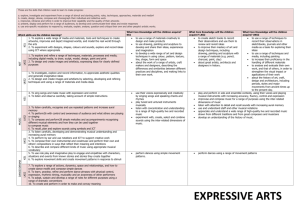High School Music Scope & Sequence
advertisement
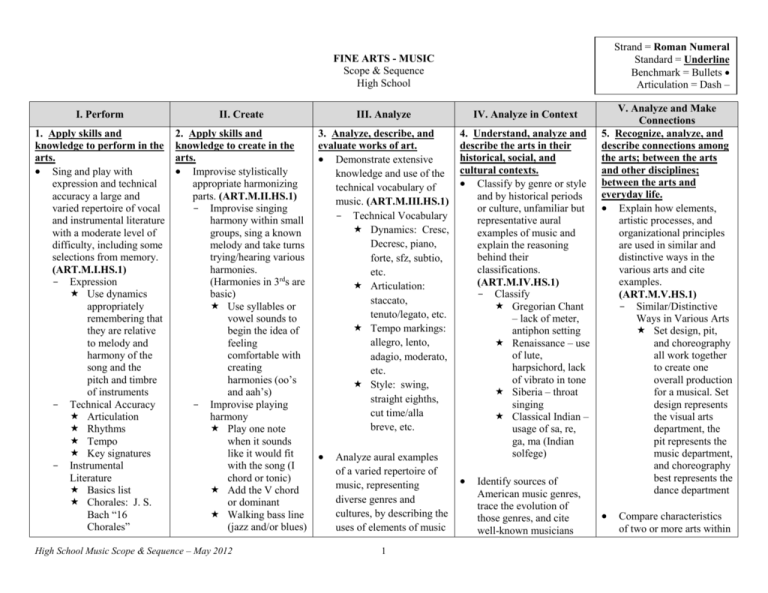
Strand = Roman Numeral Standard = Underline Benchmark = Bullets Articulation = Dash – FINE ARTS - MUSIC Scope & Sequence High School I. Perform II. Create III. Analyze IV. Analyze in Context 1. Apply skills and knowledge to perform in the arts. Sing and play with expression and technical accuracy a large and varied repertoire of vocal and instrumental literature with a moderate level of difficulty, including some selections from memory. (ART.M.I.HS.1) - Expression Use dynamics appropriately remembering that they are relative to melody and harmony of the song and the pitch and timbre of instruments - Technical Accuracy Articulation Rhythms Tempo Key signatures - Instrumental Literature Basics list Chorales: J. S. Bach “16 Chorales” 2. Apply skills and knowledge to create in the arts. Improvise stylistically appropriate harmonizing parts. (ART.M.II.HS.1) - Improvise singing harmony within small groups, sing a known melody and take turns trying/hearing various harmonies. (Harmonies in 3rds are basic) Use syllables or vowel sounds to begin the idea of feeling comfortable with creating harmonies (oo’s and aah’s) - Improvise playing harmony Play one note when it sounds like it would fit with the song (I chord or tonic) Add the V chord or dominant Walking bass line (jazz and/or blues) 3. Analyze, describe, and evaluate works of art. Demonstrate extensive knowledge and use of the technical vocabulary of music. (ART.M.III.HS.1) - Technical Vocabulary Dynamics: Cresc, Decresc, piano, forte, sfz, subtio, etc. Articulation: staccato, tenuto/legato, etc. Tempo markings: allegro, lento, adagio, moderato, etc. Style: swing, straight eighths, cut time/alla breve, etc. 4. Understand, analyze and describe the arts in their historical, social, and cultural contexts. Classify by genre or style and by historical periods or culture, unfamiliar but representative aural examples of music and explain the reasoning behind their classifications. (ART.M.IV.HS.1) - Classify Gregorian Chant – lack of meter, antiphon setting Renaissance – use of lute, harpsichord, lack of vibrato in tone Siberia – throat singing Classical Indian – usage of sa, re, ga, ma (Indian solfege) High School Music Scope & Sequence – May 2012 Analyze aural examples of a varied repertoire of music, representing diverse genres and cultures, by describing the uses of elements of music 1 Identify sources of American music genres, trace the evolution of those genres, and cite well-known musicians V. Analyze and Make Connections 5. Recognize, analyze, and describe connections among the arts; between the arts and other disciplines; between the arts and everyday life. Explain how elements, artistic processes, and organizational principles are used in similar and distinctive ways in the various arts and cite examples. (ART.M.V.HS.1) - Similar/Distinctive Ways in Various Arts Set design, pit, and choreography all work together to create one overall production for a musical. Set design represents the visual arts department, the pit represents the music department, and choreography best represents the dance department Compare characteristics of two or more arts within I. Perform - Marches: composers, Karl King, John Phillip Sousa, etc. Ballads Overtures Vocal Literature Eric Whitacre – Seal Lullaby Randall Thompson – The Pasture Moses Hogan – I Am His Child Persichetti – Dominic Has a Doll Sing music written in four parts, with or without accompaniment. (ART.M.I.HS.2) - Sing Ralph Manuel – Alleluia The Awakening Perform an appropriate part in large and small ensembles, demonstrating well-developed ensemble skills. (ART.M.I.HS.3) - Perform Using all musical skills: dynamics, articulation, correct notes, key II. Create Improvise rhythmic and melodic variations given pentatonic melodies, and melodies in major and minor keys. (ART.M.II.HS.2) - Improvise Singing Have students take a familiar piece, classical or popular, best to find a karaoke or instrumental recording, change the rhythm and melody in a slight variation - Improvise Playing Have solo(ists) improvise a melody using only the 5 notes of the Pentatonic scale while band plays I-IV-V-I Have students improvise melody using pentatonic scale plus other neighboring tones Improvise harmony underneath a pentatonic melody, either major and/or High School Music Scope & Sequence – May 2012 III. Analyze and expressive devices. (ART.M.III.HS.2) - Musical genres and cultures Have students describe the difference between Jazz and Blues Have students describe the difference between the different eras of classical music Have students describe the difference between early rock and current rock and roll. Identify and explain compositional devices and techniques and their purposes, giving examples of other works that make similar uses of these devices and techniques. (ART.M.III.HS.3) - Identify compositional devices and techniques 2 IV. Analyze in Context associated with them. (ART.M.IV.HS.2) - Identify American music genres Jazz (Duke Ellington, Ella Fitzgerald, Billie Holiday, Theloneus Monk, Miles Davis, Charlie Parker, Winton Marseilles) Rap (Sugar Hill Gang – Rappers Delight, Run DMC, Jay-Z) Country – (Hank Williams, Glen Campbell, Minnie Pearl, Patsy Cline, Dolly Parton, Kenny Rodgers, Taylor Swift, Lady Antebellum) Rock – Elvis, Beatles, Rolling Stones, Aerosmith, Metallica, AC/DC) Pop – The Temptations, The Funk Brothers, Aretha Franklin, Stevie Wonder, Michael Jackson, Cyndi Lauper, V. Analyze and Make Connections a particular historical period or style and cite examples from various cultures. (ART.M.V.HS.2) - Renaissance Periods Does music from the Renaissance period match up with the visual arts from the same period? Does music from the Renaissance period match up with theatre? dance? Are the characteristics similar culture to culture? (throughout the world?) Explain ways in which the principles and subject matter of various disciplines outside the arts are interrelated with those of music. (ART.M.V.HS.3) - Various Subject Matters Science – physics (frequency) History – music history (composers, I. Perform signature changes, time signature changes Listening to their own sections and other sections in ensemble, whether they are instrumental and/or vocal Perform music using instruments (traditional and non-traditional) and electronic media. (ART.M.I.HS.4) - Instruments Traditional: flute, clarinet, saxophones, trumpet/cornet, etc. Non-traditional: Blue Man Group style; brooms, trash cans, utensils, etc. - Electronic Media Use of iPad/iPod apps, Finale, Sibelius, Smart Music, etc. Perform from an instrumental or vocal score of at least four staves. (ART.M.I.HS.5) II. Create III. Analyze minor Improvise original melodies over given chord progressions, each in a constant style, meter, and tonality. (ART.M.II.HS.3) - Improvise Singing Have students create melodies using scat syllables (Jazz) to begin - Improvise Playing Have students create melodies using a small portion of the main theme Have students create a melody using the entire main theme Compose music in several different styles; demonstrate creativity in using the elements of music for expressive effect. (ART.M.II.HS.4) - Compose Sing basic chord progressions (I.IV.V) and have students create melodies first, High School Music Scope & Sequence – May 2012 - Finale, Sibelius, SmartMusic, GarageBand Explain compositional devices and techniques Have students compose a short song using the above stated software Evaluate the use of music in mixed media environments. (ART.M.III.HS.4) - Movies Have students describe how various types of music affects the mood of the various scenes in a movie - Radio Have students experiment with sound effects, for example a radio show Make informed, critical 3 V. Analyze and Make Connections styles) English – lyrical assessment Mathematics – note values, time signatures, addition, subdivision IV. Analyze in Context Madonna, Mariah Carey, Celine Dion) Identify various roles that musicians perform, cite representative individuals who have functioned in each role, and describe their activities and achievements. (ART.M.IV.HS.3) - Identify various roles Composer- one who creates/ writes music Arranger- one who takes an already composed piece and creates a variation on it Lyricist – one who creates lyrics to set to a provided melodic line or chord progressions Instrumentalist – those who play instruments Vocalist – those who sing Conductor – one who leads a large vocal or instrumental ensemble Explain how the roles of creators, performers, and others involved in the production and presentation of the arts are similar to and different from one another in the various arts and disciplines outside of the arts. (ART.M.V.HS.4) - Roles in the Various Arts Musical: Choreographerdance; Director – oversees all , light design; Set Design – creates sets for the stage, scene-to-scene; Sound Engineermicrophones, levels; Vocal Director – instructs vocal lines, soloists, and chorus I. Perform - II. Create Perform Perform an accompanied duet, trio, quartet, 4 part voicing, etc. Sight read accurately and expressively, music with a moderate level of difficulty. (ART.M.I.HS.6) - Accurately Sight Read Time signature, any changes Key signature, any changes Repeats, coda’s (D.S., D.C., Fine) Accidentals/ transitions Style changes (straight eighths, swing, cut time, etc.) Tempo, any changes Solfege syllables - Expressively Sight Read Dynamics Mood III. Analyze followed by lyrics Students should use solfege to help notate their melodies on staff paper Arrange pieces for voices or instruments, other than those for which the pieces were written, in ways that preserve or enhance the expressive effect of the music. (ART.M.II.HS.5) - Arrange pieces for voices Arranging vocal lines that may benefit not only the piece but also the choir in a better way Having alto’s sing a baritone part an octave higher Arranging a pop choral arrangement from what is written in the score to what is truer from the original recording - Arrange pieces for instruments Arrange a part for another instrument that is High School Music Scope & Sequence – May 2012 evaluations of the quality and effectiveness of performances, compositions, arrangements, and improvisations applying specific criteria. (ART.M.III.HS.5) - Critique Have students critique a performance, either their own and/or another group within school or outside of school Evaluate a performance, composition, arrangement, or improvisation by comparing it to similar or exemplary models. (ART.M.III.HS.6) - Compare/contrast Have students listen to a professional recording and a recording of the same song they played and 4 IV. Analyze in Context Producer – one who provides musical direction, facilitator and mixes music as well as creates music, especially for pop genres Analyze the impact of electronic music media in society and culture. (ART.M.IV.HS.4) - Electronic music in society/culture How has technology evolved in the past 10 years? In the past 20 years? How has technology changed the face of music? Listen to music from the 50’s and today. How much is live versus electronic? What other similarities/ differences are there? V. Analyze and Make Connections Analyze and consider the use of music and media for the future. (ART.M.V.HS.5) - Analyze Music & Media Discuss how music is used in various media forms today Bring/show examples Based off of music and media in the past five years, discuss where it can go in the next five years I. Perform II. Create not present in the band or needs extra reinforcement III. Analyze explain the similarities and differences. Compose and arrange music for voices and various acoustic and electronic instruments, demonstrating knowledge of the ranges and traditional usage of the sound sources. (ART.M.II.HS.6) - Compose/Arrange for voices Students compose an 8-16 measure piece using 2 part harmonies, keeping in mind the ranges of each part Students compose an 8-16 measure piece using 4 part harmonies, keeping in mind the ranges of each part Students adapt/arrange a familiar song, popular or classical, creating simple 2, 3 or 4part harmonies High School Music Scope & Sequence – May 2012 5 IV. Analyze in Context V. Analyze and Make Connections I. Perform II. Create - III. Analyze Compose/Arrange for instruments Have students compose a simple 8-10 measure song for their instrument Have students compose a simple 8-10 measure song for an instrument not theirs or in their family, for example a woodwind compose for a brass or percussion Create or adapt music to integrate with other media. (ART.M.II.HS.7) - Create/Adapt Watch a relatively short movie scene without any audio. Have students interpret what is occurring in the scene and decide what kind of music will help enhance the emotions within the scene Have students use High School Music Scope & Sequence – May 2012 6 IV. Analyze in Context V. Analyze and Make Connections I. Perform II. Create III. Analyze recording software (e.g. GarageBand) to record music they either composed as a band/choir or arranged off of a familiar piece and set it to the movie clip Have students assess the scene for sound effects (not music related) that can be added to the scene High School Music Scope & Sequence – May 2012 7 IV. Analyze in Context V. Analyze and Make Connections
